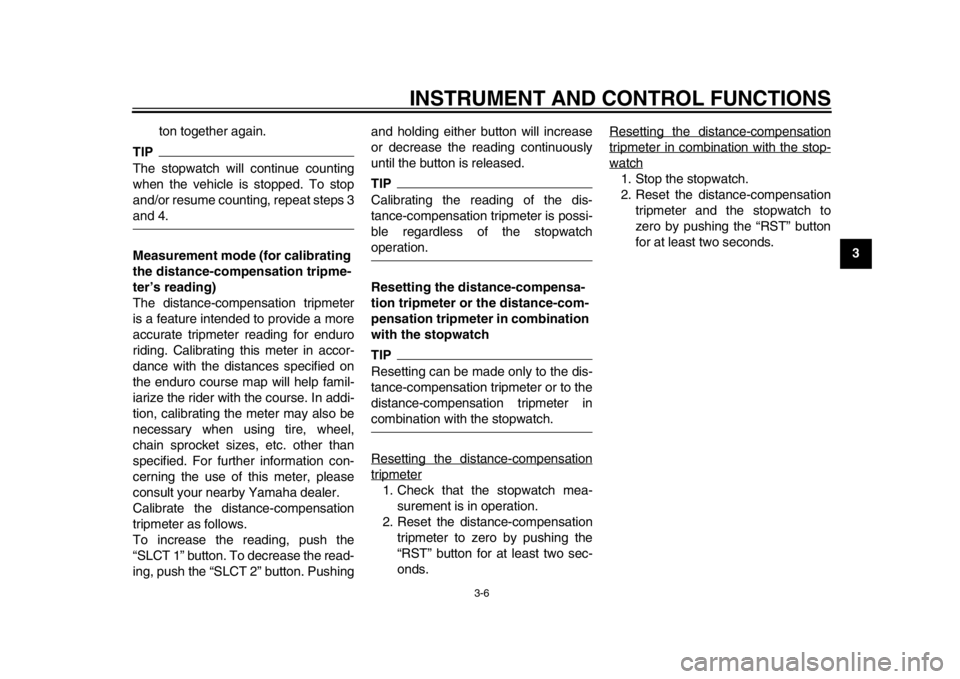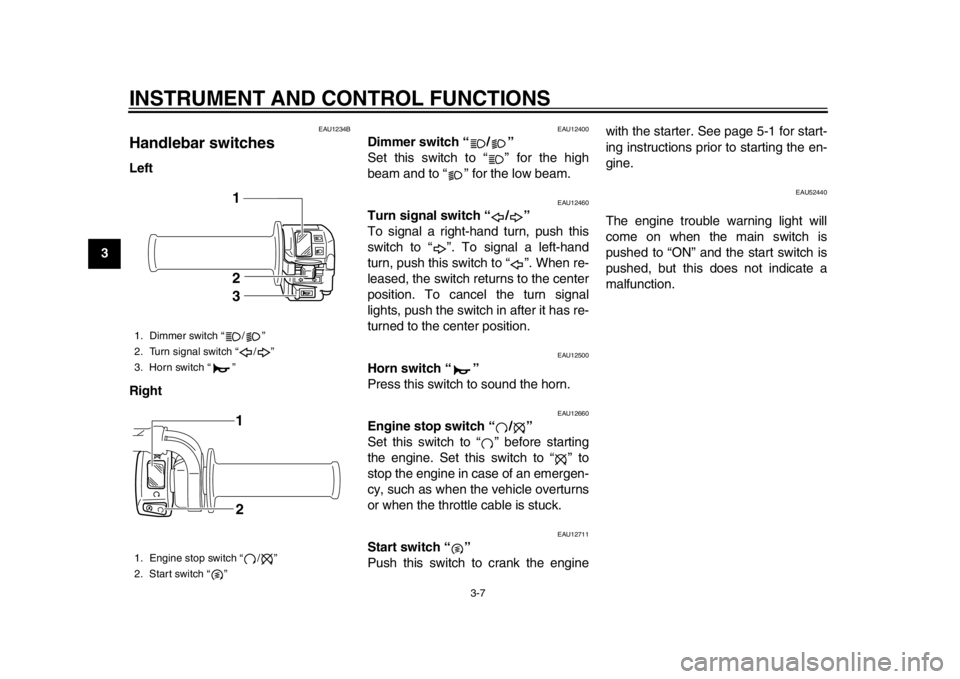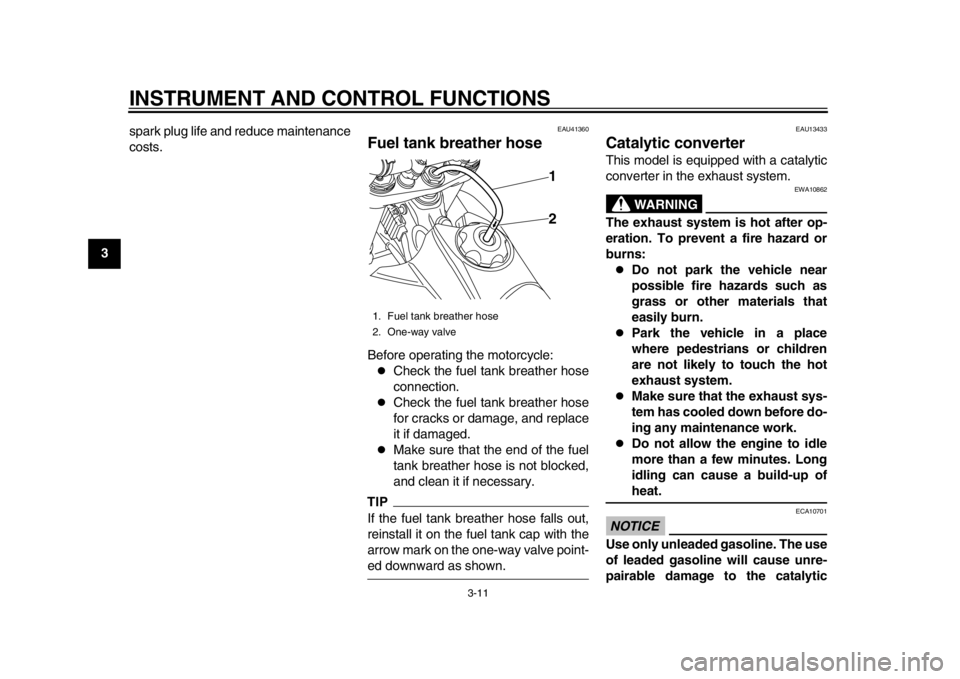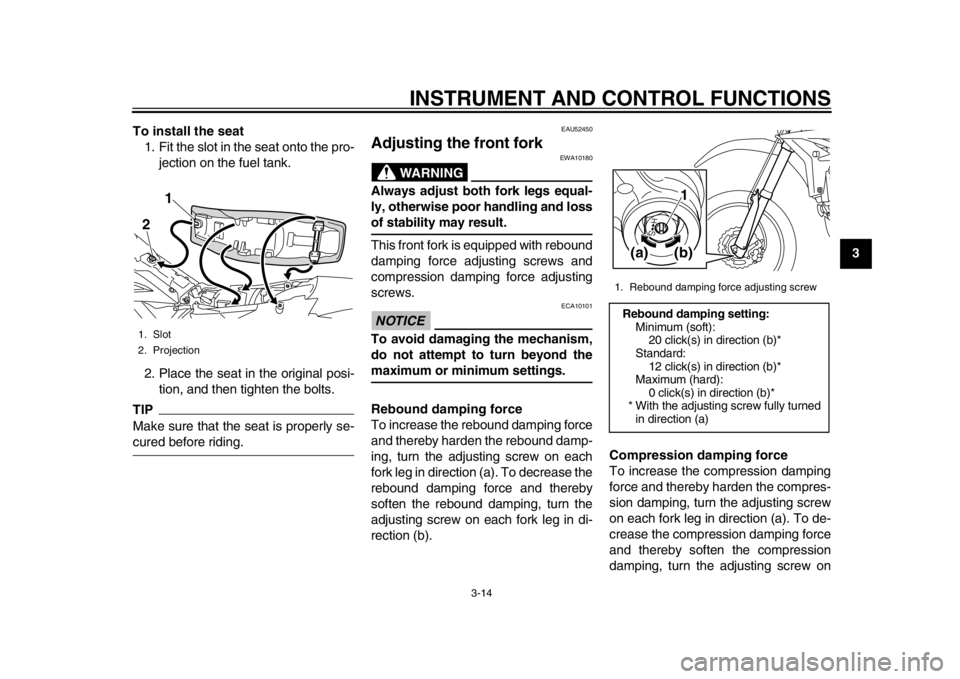YAMAHA WR 450F 2013 Owner's Manual
Manufacturer: YAMAHA, Model Year: 2013, Model line: WR 450F, Model: YAMAHA WR 450F 2013Pages: 98, PDF Size: 2.59 MB
Page 21 of 98

INSTRUMENT AND CONTROL FUNCTIONS
3-6
234
5
6
7
8
9
ton together again.
TIPThe stopwatch will continue counting
when the vehicle is stopped. To stop
and/or resume counting, repeat steps 3and 4.
Measurement mode (for calibrating
the distance-compensation tripme-
ter’s reading)
The distance-compensation tripmeter
is a feature intended to provide a more
accurate tripmeter reading for enduro
riding. Calibrating this meter in accor-
dance with the distances specified on
the enduro course map will help famil-
iarize the rider with the course. In addi-
tion, calibrating the meter may also be
necessary when using tire, wheel,
chain sprocket sizes, etc. other than
specified. For further information con-
cerning the use of this meter, please
consult your nearby Yamaha dealer.
Calibrate the distance-compensation
tripmeter as follows.
To increase the reading, push the
“SLCT 1” button. To decrease the read-
ing, push the “SLCT 2” button. Pushing and holding either button will increase
or decrease the reading continuously
until the button is released.
TIPCalibrating the reading of the dis-
tance-compensation tripmeter is possi-
ble regardless of the stopwatchoperation.
Resetting the distance-compensa-
tion tripmeter or the distance-com-
pensation tripmeter in combination
with the stopwatchTIPResetting can be made only to the dis-
tance-compensation tripmeter or to the
distance-compensation tripmeter incombination with the stopwatch.
Resetting the distance-compensationtripmeter1. Check that the stopwatch mea-
surement is in operation.
2. Reset the distance-compensation tripmeter to zero by pushing the
“RST” button for at least two sec-
onds. Resetting the distance-compensation
tripmeter in combination with the stop-watch1. Stop the stopwatch.
2. Reset the distance-compensation
tripmeter and the stopwatch to
zero by pushing the “RST” button
for at least two seconds.
1DX-9-E1.book 6 ページ 2012年7月31日 火曜日 午前9時31分
Page 22 of 98

INSTRUMENT AND CONTROL FUNCTIONS
3-7
1
23
4
5
6
7
8
9
EAU1234B
Handlebar switches Left
Right
EAU12400
Dimmer switch “ / ”
Set this switch to “ ” for the high
beam and to “ ” for the low beam.
EAU12460
Turn signal switch “ / ”
To signal a right-hand turn, push this
switch to “ ”. To signal a left-hand
turn, push this switch to “ ”. When re-
leased, the switch returns to the center
position. To cancel the turn signal
lights, push the switch in after it has re-
turned to the center position.
EAU12500
Horn switch “ ”
Press this switch to sound the horn.
EAU12660
Engine stop switch “ / ”
Set this switch to “ ” before starting
the engine. Set this switch to “ ” to
stop the engine in case of an emergen-
cy, such as when the vehicle overturns
or when the throttle cable is stuck.
EAU12711
Start switch “ ”
Push this switch to crank the enginewith the starter. See page 5-1 for start-
ing instructions prior to starting the en-
gine.
EAU52440
The engine trouble warning light will
come on when the main switch is
pushed to “ON” and the start switch is
pushed, but this does not indicate a
malfunction.
1. Dimmer switch “ / ”
2. Turn signal switch “ / ”
3. Horn switch “ ”
1. Engine stop switch “ / ”
2. Start switch “ ”
1
2
31
2
1DX-9-E1.book 7 ページ 2012年7月31日 火曜日 午前9時31分
Page 23 of 98

INSTRUMENT AND CONTROL FUNCTIONS
3-8
234
5
6
7
8
9
EAU12820
Clutch lever The clutch lever is located at the left
handlebar grip. To disengage the
clutch, pull the lever toward the handle-
bar grip. To engage the clutch, release
the lever. The lever should be pulled
rapidly and released slowly for smooth
clutch operation.
The clutch lever is equipped with a
clutch switch, which is part of the igni-
tion circuit cut-off system. (See
page 3-19.)
EAU12871
Shift pedal The shift pedal is located on the left
side of the motorcycle and is used in
combination with the clutch lever when
shifting the gears of the 5-speed con-
stant-mesh transmission equipped on
this motorcycle.
EAU41264
Brake lever The brake lever is located on the right
side of the handlebar. To apply the front
brake, pull the lever toward the throttle
grip.
The brake lever is equipped with a
brake lever position adjusting bolt. Ad-
just the distance between the brake le-
ver and the throttle grip as follows.1. Slide the rubber cover toward the end of the brake lever.
2. Loosen the locknut.
1. Clutch lever
1
1. Shift pedal
1
1. Rubber cover
2. Brake lever
3. Distance between brake lever and throttle grip
4. Locknut
5. Brake lever position adjusting bolt
1
2
3
4
5
(b)
(a)
1DX-9-E1.book 8 ページ 2012年7月31日 火曜日 午前9時31分
Page 24 of 98

INSTRUMENT AND CONTROL FUNCTIONS
3-9
1
23
4
5
6
7
8
93. While holding the lever pushed
away from the throttle grip, turn the
adjusting bolt in direction (a) to in-
crease the distance, and in direc-
tion (b) to decrease it.
4. Tighten the locknut.
5. Slide the rubber cover to its origi- nal position.
EAU12941
Brake pedal The brake pedal is on the right side of
the motorcycle. To apply the rear
brake, press down on the brake pedal.
EAU13182
Fuel tank cap To remove the fuel tank cap, turn it
counterclockwise, and then pull it off.
To install the fuel tank cap, insert it into
the tank opening, and then turn it clock-
wise.
WARNING
EWA11091
Make sure that the fuel tank cap is
properly closed after filling fuel.Leaking fuel is a fire hazard.
Distance between the brake lever
and the throttle grip:Minimum (shortest):
76 mm (2.99 in)
Standard: 95 mm (3.74 in)
Maximum (longest): 97 mm (3.82 in)
1. Brake pedal
1
1. Fuel tank cap
1
1DX-9-E1.book 9 ページ 2012年7月31日 火曜日 午前9時31分
Page 25 of 98

INSTRUMENT AND CONTROL FUNCTIONS
3-10
234
5
6
7
8
9
EAU13212
Fuel Make sure there is sufficient gasoline in
the tank.
WARNING
EWA10881
Gasoline and gasoline vapors are
extremely flammable. To avoid fires
and explosions and to reduce the
risk of injury when refueling, followthese instructions.1. Before refueling, turn off the en- gine and be sure that no one is sit-
ting on the vehicle. Never refuel
while smoking, or while in the vi-
cinity of sparks, open flames, or
other sources of ignition such as
the pilot lights of water heaters and
clothes dryers.
2. Do not overfill the fuel tank. Stop filling when the fuel reaches the
bottom of the filler tube. Because
fuel expands when it heats up,
heat from the engine or the sun
can cause fuel to spill out of the
fuel tank. 3. Wipe up any spilled fuel immedi-
ately. NOTICE: Immediately wipe
off spilled fuel with a clean, dry,
soft cloth, since fuel may deteri-
orate painted surfaces or plastic
parts.
[ECA10071]
4. Be sure to securely close the fuel tank cap.
WARNING
EWA15151
Gasoline is poisonous and can
cause injury or death. Handle gaso-
line with care. Never siphon gaso-
line by mouth. If you should swallow
some gasoline or inhale a lot of gas-
oline vapor, or get some gasoline in your eyes, see your doctor immedi-
ately. If gasoline spills on your skin,
wash with soap and water. If gaso-
line spills on your clothing, change
your clothes.
EAU13391
NOTICE
ECA11400
Use only unleaded gasoline. The use
of leaded gasoline will cause severe
damage to internal engine parts,
such as the valves and piston rings,as well as to the exhaust system.
Your Yamaha engine has been de-
signed to use premium unleaded gaso-
line with a research octane number of
95 or higher. If knocking (or pinging) oc-
curs, use a gasoline of a different
brand. Use of unleaded fuel will extend
1. Fuel tank filler tube
2. Maximum fuel level
21
Recommended fuel:
Premium unleaded gasoline only
Fuel tank capacity:
7.2 L (1.90 US gal, 1.58 Imp.gal)
Fuel reserve amount (when the fuel
level warning light comes on): 3.0 L (0.79 US gal, 0.66 Imp.gal)
1DX-9-E1.book 10 ページ 2012年7月31日 火曜日 午前9時31分
Page 26 of 98

INSTRUMENT AND CONTROL FUNCTIONS
3-11
1
23
4
5
6
7
8
9spark plug life and reduce maintenance
costs.
EAU41360
Fuel tank breather hose Before operating the motorcycle:
Check the fuel tank breather hose
connection.
Check the fuel tank breather hose
for cracks or damage, and replace
it if damaged.
Make sure that the end of the fuel
tank breather hose is not blocked,
and clean it if necessary.
TIPIf the fuel tank breather hose falls out,
reinstall it on the fuel tank cap with the
arrow mark on the one-way valve point-ed downward as shown.
EAU13433
Catalytic converter This model is equipped with a catalytic
converter in the exhaust system.
WARNING
EWA10862
The exhaust system is hot after op-
eration. To prevent a fire hazard or
burns:
Do not park the vehicle near
possible fire hazards such as
grass or other materials that
easily burn.
Park the vehicle in a place
where pedestrians or children
are not likely to touch the hot
exhaust system.
Make sure that the exhaust sys-
tem has cooled down before do-
ing any maintenance work.
Do not allow the engine to idle
more than a few minutes. Long
idling can cause a build-up ofheat.
NOTICE
ECA10701
Use only unleaded gasoline. The use
of leaded gasoline will cause unre-
pairable damage to the catalytic
1. Fuel tank breather hose
2. One-way valve
21
1DX-9-E1.book 11 ページ 2012年7月31日 火曜日 午前9時31分
Page 27 of 98

INSTRUMENT AND CONTROL FUNCTIONS
3-12
234
5
6
7
8
9
converter.
EAU53230
Starter knob Starting a cold engine requires a richer
air-fuel mixture, which is supplied by
the starter.
Move the knob in direction (a) to turn on
the starter.
Move the knob in direction (b) to turn off
the starter.
EAU13650
Kickstarter To start the engine, fold out the kick-
starter lever, move it down lightly with
your foot until the gears engage, and
then push it down smoothly but force-
fully. This model is equipped with a pri-
mary kickstarter, allowing the engine to
be started in any gear if the clutch is
disengaged. However, shifting the
transmission into the neutral position
before starting is recommended.
1. Starter knob/idle adjusting screw
(a)
(b)1
1. Kickstarter lever1
1DX-9-E1.book 12 ページ 2012年7月31日 火曜日 午前9時31分
Page 28 of 98

INSTRUMENT AND CONTROL FUNCTIONS
3-13
1
23
4
5
6
7
8
9
EAU53100
Steering lock To lock the steering1. Turn the handlebar all the way to the left.
2. Insert the key into the steering lock under the steering head pipe, and
then turn it 1/2 turn in either direc-
tion.
3. Check that the steering is locked, and then remove the key from the
lock.
To unlock the steering 1. Insert the key into the steering lock.
2. Turn the key 1/2 turn in either di- rection.
3. Remove the key. WARNING!
Never ride with the key inserted
into the steering lock, which
may result in loss of control and
an accident.
[EWA16160]
EAU53200
Seat To remove the seat
Remove the bolts, and then slide the
seat to the rear and pull upward.
1. Steering lock
1
1. Bolt
1. Bolt
11
1DX-9-E1.book 13 ページ 2012年7月31日 火曜日 午前9時31分
Page 29 of 98

INSTRUMENT AND CONTROL FUNCTIONS
3-14
234
5
6
7
8
9
To install the seat
1. Fit the slot in the seat onto the pro- jection on the fuel tank.
2. Place the seat in the original posi- tion, and then tighten the bolts.
TIPMake sure that the seat is properly se-cured before riding.
EAU52450
Adjusting the front fork
WARNING
EWA10180
Always adjust both fork legs equal-
ly, otherwise poor handling and lossof stability may result.
This front fork is equipped with rebound
damping force adjusting screws and
compression damping force adjusting
screws.NOTICE
ECA10101
To avoid damaging the mechanism,
do not attempt to turn beyond themaximum or minimum settings.
Rebound damping force
To increase the rebound damping force
and thereby harden the rebound damp-
ing, turn the adjusting screw on each
fork leg in direction (a). To decrease the
rebound damping force and thereby
soften the rebound damping, turn the
adjusting screw on each fork leg in di-
rection (b). Compression damping force
To increase the compression damping
force and thereby harden the compres-
sion damping, turn the adjusting screw
on each fork leg in direction (a). To de-
crease the compression damping force
and thereby soften the compression
damping, turn the adjusting screw on
1. Slot
2. Projection2
1
1. Rebound damping force adjusting screwRebound damping setting:
Minimum (soft):
20 click(s) in direction (b)*
Standard: 12 click(s) in direction (b)*
Maximum (hard): 0 click(s) in direction (b)*
* With the adjusting screw fully turned
in direction (a)
1
(a) (b)
1DX-9-E1.book 14 ページ 2012年7月31日 火曜日 午前9時31分
Page 30 of 98

INSTRUMENT AND CONTROL FUNCTIONS
3-15
1
23
4
5
6
7
8
9each fork leg in direction (b).
TIPAlthough the total number of clicks of a
damping force adjusting mechanism
may not exactly match the above spec-
ifications due to small differences in
production, the actual number of clicks
always represents the entire adjusting range. To obtain a precise adjustment,
it would be advisable to check the num-
ber of clicks of each damping force ad-
justing mechanism and to modify the
specifications as necessary.
EAU14793
Front fork bleeding
WARNING
EWA10200
Always bleed both fork legs, other-
wise poor handling and loss of sta-bility may result.
When riding in extremely rough condi-
tions, the air temperature and pressure
in the front fork will rise. This will in-
crease the spring preload and harden
the front suspension. If this occurs,
bleed the front fork as follows.
1. Lift the front wheel off the ground according to the procedure on
page 6-36.TIPWhen bleeding the front fork, there
should be no weight on the front end ofthe vehicle.
2. Remove the bleed screws and al- low all of the air to escape from
each fork leg.
1. Compression damping force adjusting screwCompression damping setting:Minimum (soft):
20 click(s) in direction (b)*
Standard: 14 click(s) in direction (b)*
Maximum (hard): 0 click(s) in direction (b)*
* With the adjusting screw fully turned
in direction (a)
(a)(b)
1
1DX-9-E1.book 15 ページ 2012年7月31日 火曜日 午前9時31分